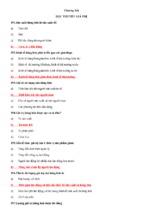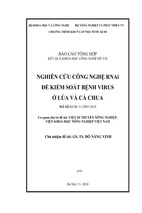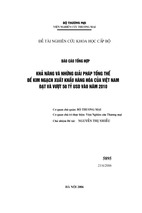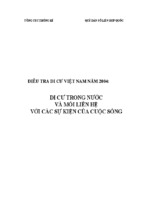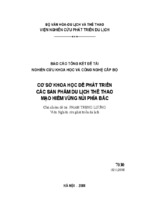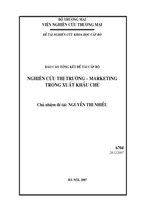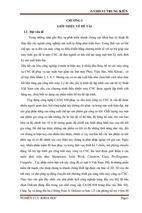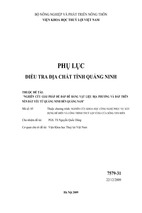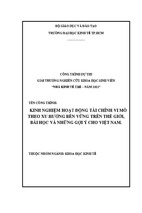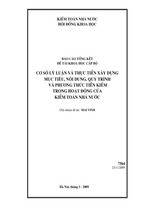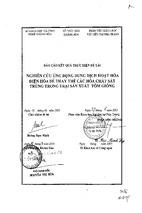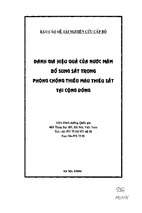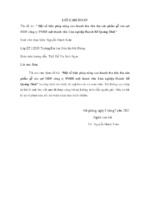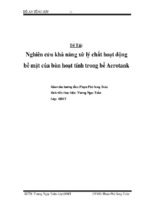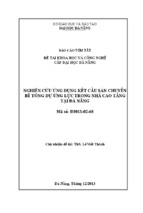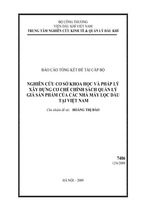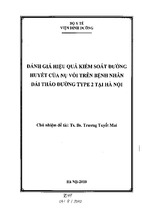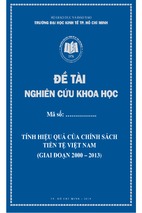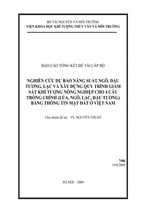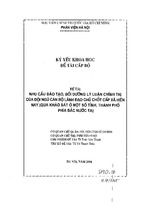THE IMPORTANCE AND IMPACTS OFCOSTING
METHOD ON THE PROCESS OF MANAGERIAL
DECISION MAKING
BY
NGUYEN THUY LINH
E0600085
BARCHELOR OF BUSINESS (ACCOUNTING) HONS
HELP UNIVERITY COLLEGE
OCTOBER 2010
i
DECLARATION OF ORGINALITY AND
WORD COUNT
I hereby declare that the graduation project is based on my original work except
quotations and citations, which has been duly acknowledged. I also declare that it has
not been previously or concurrently submitted for any other course/degree at Help
University or other institutions. The word count is 11436 words.
NGUYEN THUY LINH
28 October 2010
i
ACKNOWLEDGEMENT
First of all, I would like to express my sincere appreciation to my supervisor, Dr. Le Van
Lien who has guided me throughout this thesis. His constant guidance, insightful
suggestions, and constructive ideas are the essential inputs and encouragement for me in
order to complete this thesis.
Next, I would like to acknowledge to manager and all of employees in Nghe An Joint
Stock Company Medicine – Medical Materials who allowed and assisted me to collect
all of necessary information for me to get this thesis done. Without their contribution, I
could not be able to gather much information for my research.
Lastly, I would also like to extend my heartfelt gratitude to my friends for their
continuous support, encouragement and contribution, which have been crucial during the
presentation of this report.
My thesis cannot be finished without your supports.
ii
TABLE OF CONTENT
DECLARATION OF ORGINALITY AND WORD COUNT ...... Error! Bookmark not
defined.
ACKNOWLEDGEMENT ..................................................... Error! Bookmark not defined.
TABLE OF CONTENT ...................................................................................................................... iii
ABSTRACT ............................................................................................................................................ vi
LIST OF FIGURES ............................................................................................................................. vii
LIST OF TABLES .............................................................................................................................. viii
CHAPTER 1: INTRODUCTION ...................................................................................................... 1
1.1
Introduction of topic ........................................................................................................... 1
1.2
Problem statement ............................................................................................................... 2
1.3 Issues expansion ......................................................................................................................... 4
1.4 Structure of the research ........................................................................................................... 5
CHAPTER 2: LITERATURE REVIEW ......................................................................................... 6
2.1 Managerial decision-making process.................................................................................... 6
2.1.2 What is decision making process?................................................................................. 8
2.1.3 What is accounting information and its role in decision-making process? ..... 10
2.1.4 Managers and management accounting ..................................................................... 12
2.2 The importance and impacts of costs accounting methods on decision-making
process of the managers using SWOT model analysis. ........................................................ 14
2.2.1 Absorption costing ........................................................................................................... 14
Figure 1: Absorption costing method ................................................................................... 14
2.2.2 Variable costing method................................................................................................. 16
Figure 2: Variable costing method ........................................................................................ 16
2.2.3 Activity based costing system (ABC) ........................................................................ 18
iii
2.2.4 The importance and impacts of accounting methods on managerial decision
making process. ........................................................................................................................... 21
CHAPTER 3: RESEARCH AND METHODLOGY................................................................. 27
3.1 Aims of the project ................................................................................................................... 27
3.2 Research methodology ............................................................................................................ 28
3.3 Data sources ............................................................................................................................... 29
3.4 Limitation.................................................................................................................................... 29
CHAPTER 4: CASE STUDY ANALYSIS .................................................................................. 31
4.1 Introduction ................................................................................................................................ 31
4.1.1 Process of formation and development of the company ....................................... 32
4.1.2 Facilities of the company ............................................................................................... 33
4.1.3 Company’s mission statement ...................................................................................... 34
4.1.4 Potention on production of the company................................................................... 34
4.1.5 Potention on marketing of the company .................................................................... 35
4.1.6 Structure of Nghe An Joint Stock Medicine – Medical Materials’ management
structure ......................................................................................................................................... 36
Figure 3: Structure of management team ............................................................................ 36
4.1.7 Accounting policy adopted ............................................................................................ 37
4.2 Difference when using different cost accounting methods .......................................... 38
4.2.1 Incurred expenses during the period of 2008 – 2009 ............................................. 38
Table 1: Total revenue for Vitamin C of Nghe An Joint Stock Company Medicine Medical Materials ....................................................................................................................... 39
Table 2: Direct material cost of Nghe An Joint Stock Company Medicine – Medical
Materials........................................................................................................................................ 39
Table 3: Direct labor cost of Nghe An Joint Stock Company Medicine – Medical
Material ......................................................................................................................................... 41
Table 4: Manufacturing overhead cost of Nghe An Joint Stock Company Medicine –
Medical Materials ....................................................................................................................... 42
4.2.2 Cost of goods manufactured under absorption costing method and variable
costing method ............................................................................................................................. 43
iv
Table 5: Cost of Vitamin C using absorption cost and variable cost method ........... 43
4.2.3 A profit comparison using absorption costing and variable costing method to
calculate ......................................................................................................................................... 44
Table 6: Cost of good sold for Vitamin C ............................................................................ 44
Table 7: Gross profit for Vitamin C ...................................................................................... 45
Table 8: Variable cost of goods sold for Vitamin C ......................................................... 45
Table 9: Contribution margin for Vitamin C ...................................................................... 46
Table 10: Difference between variable costing and absorption costing..................... 46
CHAPTER 5: CONCLUSION AND RECOMMENDATION............................................... 48
5.1 Conclusion .................................................................................................................................. 48
5.2 Recommendation for calculating product cost of Nghe An ......................................... 49
Joint Stock Company Medicine – Medical Materials. .......................................................... 49
REFERENCE…………………………………………………………………………...51
v
THE IMPORTANCE AND IMPACTS OFCOSTING METHOD ON
THE PROCESS OF MANAGERIAL DECISION MAKING
BY
NGUYEN THUY LINH
OCTOBER 2010
Supervisor: Dr. LE VAN LIEN
ABSTRACT
The purpose of this paper is to analysis the importance and impacts of cost accounting
method on decision-making process of managers. Cost accounting method can be
considered as the most concerning problem with an organization, according to different
costing methods will lead to different profit to a company, therefore choosing a suitable
costing method is very important for managers. There are three cost accounting
methods, namely absorption costing method, variable costing method, activity-based
costing method are analysis in this thesis. And SWOT model will be used to explore the
advantages and disadvantage of each method. After that, I make some recommendation
for calculating product cost of Nghe An Joint Stock Company Medicine – Medical
Materials.
vi
LIST OF FIGURES
Figure 1: Absorption costing method
Figure 2: Variable costing method
Figure 3: Structure of management team
vii
LIST OF TABLES
Table 1: Total revenue for Vitamin C of Nghe An Joint Stock Company Medicine Medical Materials
Table 2: Direct material cost of Nghe An Joint Stock Company Medicine – Medical
Materials
Table 3: Direct labor cost of Nghe An Joint Stock Company Medicine – Medical
Materials
Table 4: Manufacturing overhead cost of Nghe An Joint Stock Company Medicine –
Medical Materials
Table 5: Cost of Vitamin C using absorption cost and variable cost method
Table 6: Cost of good sold for Vitamin C
Table 7: Gross profit for Vitamin C
Table 8: Variable cost of goods sold for Vitamin C
Table 9: Contribution margin for Vitamin C
Table 10: Difference between variable costing and absorption costing
viii
CHAPTER 1: INTRODUCTION
In this chapter, the whole picture about the ideas of this thesis will be depicted, and these
help users easy to follow and link them to each other to figure out the potential
relationship between cost accounting methods and managerial decision making process.
This chapter will cover the structure of this thesis, an introduction about the topic as well
as related issues.
1.1 Introduction of topic
Historical documentation about the origins of cost accounting is limited due to a fire at
the headquarters of the National Association of Accountants (NAA) in 1984. Many
irreplaceable documents were destroyed in that fire (Cheryl Cunagin and JohnL. Stancil,
1992). Therefore, no one can ensure and know about the accurate time that the cost
accounting methods were born. As Richard Vangermeersch, a leading accounting
historian explains that a problem in cost accounting is that many accountants feel that
they have no past. As a result, nowadays-costing management accounting is not a new
problem but their impacts and importance are the central issues to be researched.
Cost accounting is the process of accounting for cost, which begins with regarding and
classifying costs and ends with the preparing periodical statements and reports for
ascertaining and controlling costs. Today, cost accounting may be defined as the process
1
of measuring, analyzing, computing, and reporting the cost. There are different cost
accountings methods that need managers can choice and based on their results manager
can use for making better decisions in the future. These methods are absorption costing
method, variable costing method, activity-based costing method, throughput costing, etc.
Absorption costing is know as traditional cost accounting, this method makes no
distinction between fixed and variable costs; therefore it is not well suited for cost
volume profit computation, which is important for good planning and control. Therefore,
absorption costing method might be the best costing method for the small company.
However, other managers and accountants think using another costing method is better
than using absorption costing. For example: activity-based costing is a modern
accounting system, which segregates expenses based on specific activities and then
allocated the cost among individual items based on volume of activity, so this method
can reduce and allocate costs more efficiently. Different managers will not make the
same decision with the same information and report so making decisions will depend on
thinking of each manager. In fact, managers have decision-making process by many
factors but in this thesis, only impact and importance of cost accounting methods on the
process of managerial decision-making are discussed.
1.2 Problem statement
Main ideas of this thesis are related to cost accounting methods, their advantages and
disadvantage, as well as their impact on the decision on making process of managers.
2
In management accounting, cost accounting is that part of management accounting
which establishes standard and actual cost of operations, processes, departments or
product and the analysis of variances, profitability or social use of funds. Managers use
cost accounting information to make their decision making to reduce a company’s costs
and improve its profitability. As a form of management accounting, cost accounting
need not follow requirement of GAAP, because its primary users are internal managers,
rather than external users, and what to compute is instead decided pragmatically.
Cost accounting includes many methods but in this thesis, there are three cost
accounting methods that the author wants to focus: absorption costing method, variable
costing method, and activity-based costing method. Although many irreplaceable
documents were destroyed in a fire at the headquarters of the National Association of
Accountants (NAA) in 1984, some historical researchers thought that absorption costing
method can be regarded as the earliest of cost accounting method. After that, variable
costing method was invented. Using traditional cost accounting methods is difficult for
companies with complex processes and manufacturing practices; therefore later activitybased costing method was created out of the need to overcome these difficulties by
dividing production into its core activities. Depending on each case that manager will
choose best cost accounting method for their company, however nothing can be perfect,
and each method contain both advantages and disadvantages.
SWOT analysis is a strategic method for identifying business’s strengths and
weaknesses, and to examine the opportunities and threats in the wider environment
(market, industry, global situation). Using SWOT model, all of the advantages and
disadvantages of each cost accounting method will be judged fairly. This method often
3
uses in management aspect, the managers applied SWOT model to evaluate the
effectiveness and efficiency of the companies, cost budget, and operation process.
Analyzing cost accounting methods follow SWOT model, managers will be easier to see
the importance and impact of them on the decisions making process.
1.3 Issues expansion
After joining the World Trade Organization (WTO) in 2007 Vietnam has increasingly
opened the economy and trade. Vietnam pharmaceutical industry faces many challenges
so pharmaceutical companies will be innovated management strategy and reduce costs to
ensure competitiveness and survival. In this context, companies have actively deploying
innovative management method and running production, with particular emphasis on the
management for production costs. Therefore, in chapter 4 of this thesis, a real case of
Nghe An Joint Stock Company Medicine – Medical Materials – one medicine
manufacture will be use for analysis. From this chapter, it is easy to understand about
importance and impact of cost accounting method on decision-making process of
managers.
The chapter 4 will introduce about Nghe An Joint Stock Company Medicine – Medical
Materials, then from the collected cost information of this company, absorption costing
method and variable costing method will be applied.
4
1.4 Structure of the research
In this thesis, there are five chapters as follow:
Chapter 1: Introduction
Chapter 2: Literature review
Chapter 3: Research and methodology
Chapter 4: Case study analysis
Chapter 5: Conclusion
In this thesis, five chapters will be linked each other in order to express the ideas that the
author would like to share. Chapter 1 and chapter 3 will consider as a background to
crease the general ideas of this thesis. Chapter 2 will focus on the theory of cost
accounting method and chapter 4 is a real case, playing a supplementary role for chapter
2. And last but not least, chapter 5 will conclude the findings after analyzing a real case
compared to the theory, and some recommendations for the company.
5
CHAPTER 2: LITERATURE REVIEW
Chapter 2 will provide information about managerial decision-making process, and
introduce about the history, calculation and contents of absorption costing, variable
costing, and activity-based costing method. Understanding managerial decision-making
process and cost accounting methods can help the managers know what kind of
information and how much of information they need to make efficient decisions. After
that, SWOT model will be applied to evaluate advantages and disadvantages of each
cost accounting method.
2.1 Managerial decision-making process
People make many decisions every day. From several perspectives that decisions can be
made in different ways depending on different purposes of various groups of people.
Therefore, decision-making is a reasoning or emotional process which can be rational or
irrational, can be based on explicit assumptions or tacit assumptions. However,
managerial decision making process can be only understood by four parts. They are:
Decision in nature.
Step in decision-making.
Role of accounting information in decision-making.
Managers and management accounting.
6
2.1.1 Decision in nature
A decision is an act requiring judgment that is translated into action. Decision-making is
the process by which people respond to opportunities and threats by analyzing options,
and making decisions about goals and courses of action.
Decision process could be associated from internal and external information and people
need to choose the best alternative for a good result.
People make many decisions everyday. For example, we decide what to buy goods for
our family when going to supermarket; we decide what kinds of sports for good health.
In another case we make another difficult decision to go such as we are surrounded by
the fire: to jump through the windows and risk to killing yourself or to wait the firemen
and risk being burned to death if they come too late? What should we do? This is an
important decision for us at the moment. More important than these cases, we have to
decide what kinds of job in the future to earn a lot of money.
Our business or the affairs in our life is experiencing development and growth, we are
often faced with difficult decisions. We need to choose among many decisions; it is not
possible for us to do everything that we would like to do because time and resources are
always limited. In fact, our actions will have long reaching consequences, and will affect
the lives of others. Sometimes the pressure of having to act forces us to make a decision
that we may regret later. Sometimes this pressure causes us to waver and miss an
opportunity. For example: the representative of the UN and the general who commanded
the UN forces had been unable to make up their mind about the need for an air force
support and 7000 people were badly slaughtered.
7
There may be different styles associated with the way in which people make decisions,
or certainly that we seek different information with which to make us decisions. In
general, we ourselves, parents, children, sisters, friends, and bosses could affect our
decision, besides that following the research of a variety of aspects of decision making,
the decisions depend on sex, politics, consumers, economy, etc. Women tend to take
decisions based on emotive factors, they tend to consider the opinions of others and
weigh them up in relation to their own understanding of a decision and its causes and
effects. However, men tend to learn towards an instant solution and can be wary of
clouding issues by opening them up to too much discussion. Men tend to look at the
rights of the individuals involved and make what they intend to be fair and just
decisions.
In business, decision-making is an important of business success. Decisions are based on
a foundation of knowledge and sound reasoning can lead the company into long term
prosperity, conversely, decisions that are made on the basic of flawed logic,
emotionalism, or incomplete information can quickly put a business out of commission.
Sometimes the managers could not know every thing of various aspects, therefore when
it works, collective intelligence does come up with better solutions than could
individuals.
2.1.2 What is decision making process?
Decision-making is usually defined as the act of making up your mind about something.
However, the process of decision-making is not as easy as it sounds. There are certain
8
important decisions that you have to make that have the ability to change the course of
your life. Thus, it is important to take decisions in a systematic way, so that the decision
you make has high chances of being successful (Proctor, R., 2009).
According to Hoggett, Edward, & Merlin, 2006, decision-making follows four main
steps, they are: establish goals, gather available information on alternatives, determine
consequences of alternatives and choose a course of action.
The first step and arguably the most important step in the decision-making are
establishing goals (or what are we trying to achieve?). It is a primary importance that we
should first determine or specify our task; we must identify each situation in which a
decision is needed and determine the goals we wish to achieve. Depending on then
values, motives, desires, and different situation help us have different decisions.
Once a decision maker has established the goal, it is necessary to gather available
information on alternatives. In this second step, we are determining what information we
need as information can help change our attitudes, beliefs or expectations. We can gather
some kind of information that we are prepared to commit to making a choice. There are:
what is relevant and what is not relevant to the decision? What do you need to know
before you can make a decision or that will help you make the right one? Who knows,
who can help, who has the power and influence to make this happen (or to stop it)?
After gathering available information to help us determine the alternative available, then
the third step is determining consequences of alternatives. This step is the stage when we
have to assess each alternative we have come up with. We have to find out the
9
advantages and disadvantages of the information. At this stage, we can also select out
the information’s that is thought unfeasible or not serve our goal.
The final step deals with choosing a course of action. Once we have gone through the
previous 3 steps, after taking the alternatives available and the consequences of those
alternatives into consideration, we must choose a course of action and start to make the
goals that we wish to achieve realistic.
2.1.3 What is accounting information and its role in decisionmaking process?
The need for a decision arises in our life and business because we are faced with a
problem and alternative courses of action are available, and we need more information
when making a decision. Therefore the information plays an important role in deciding
which option to make decision process. In business, accounting information is needed
before a decision is made.
Accounting is concerned mainly with identifying transactions and recording the
financial history of the transactions of an entity; therefore a major focus on accounting
information is on actual financial events, not on future events (Hogget, Edward, &
Merlin, 2006). Although accounting information is not future events, this information is
used often as a guide to future estimates of the different alternative consequences. The
managers of the business will want to know what things are being done so they need this
10
information in order to make plans for the future; they then need more updated
information in order to check whether actual performance is on target.
Accounting information is also very useful in providing decision makers with
information about the outcomes or results of their decision (Hoggett, Edward, & Merlin,
2006). Accounting information could be used by internal and external decision maker,
such as managers, investors, creditors, customers, etc. before it can be regarded as useful
in satisfying the need of various user groups, accounting information should satisfy the
following criteria: understandability, relevance, consistency, comparability, reliability,
objectivity.
Firstly, accounting information is understandability, which means the expression, with
clarity of accounting information in such a way that it will be understandable to users –
who are generally assumed to have a reasonable knowledge of business and economic
activities.
Secondly, it is relevance that means accounting information must help a user to form,
confirm or maybe revise a view in the context of making a decision. For example:
following accounting information of the business, we can understand their financial
events, so we should invest or should not invest, we should lend money to this business
or should not, and we should work for this business or should not.
Thirdly, comparability of accounting information is very important for decision making
of investors or creditors. This implies the ability for users to be able to compare similar
companies in the same industry group and to make comparisons of performance over
time.
11
- Xem thêm -

